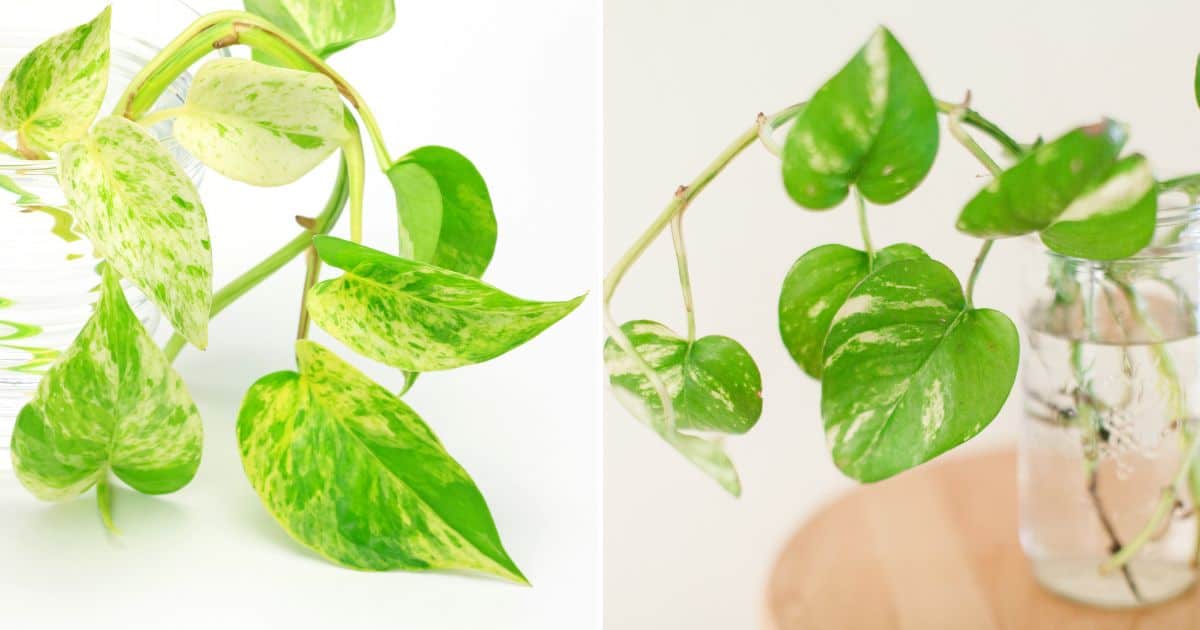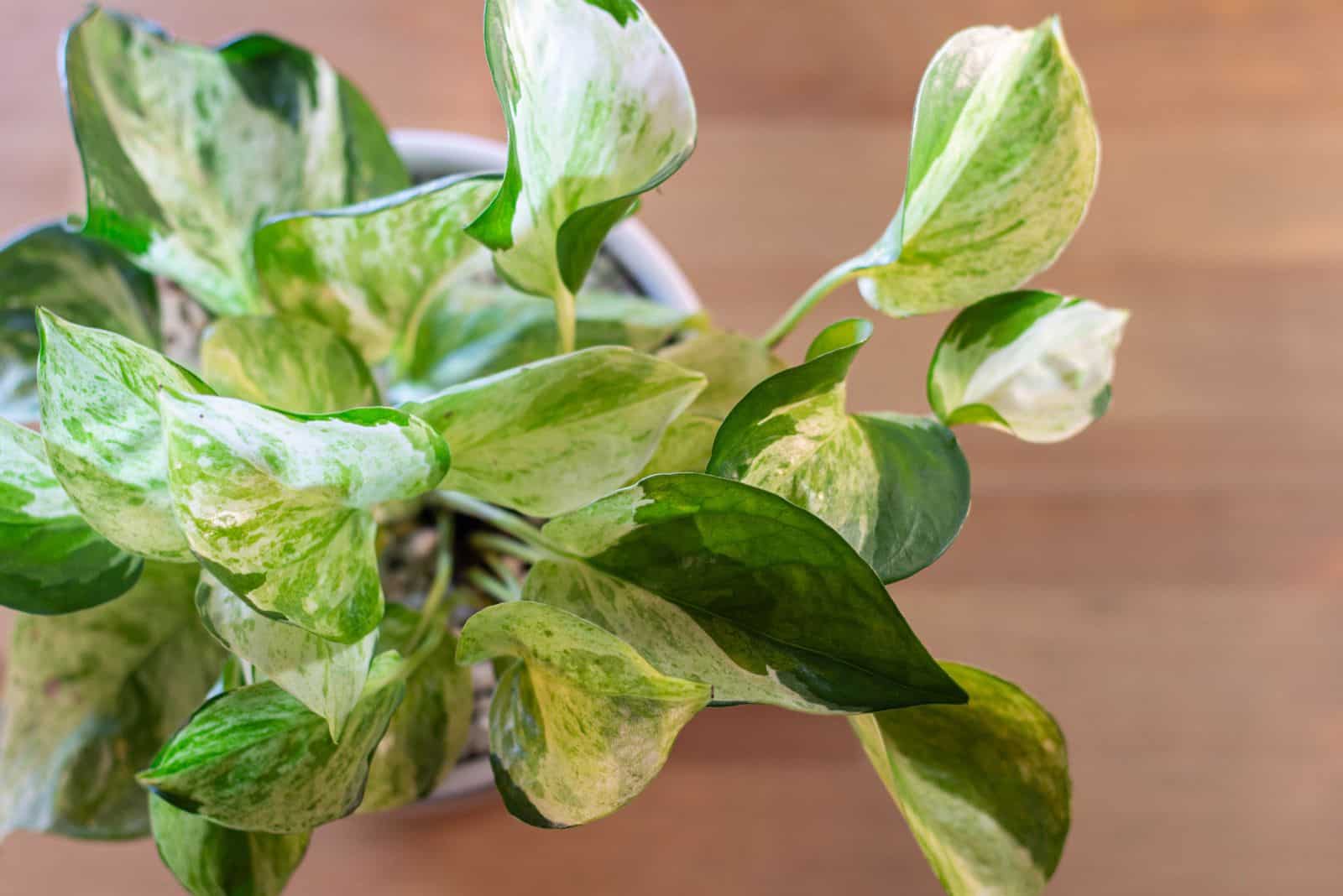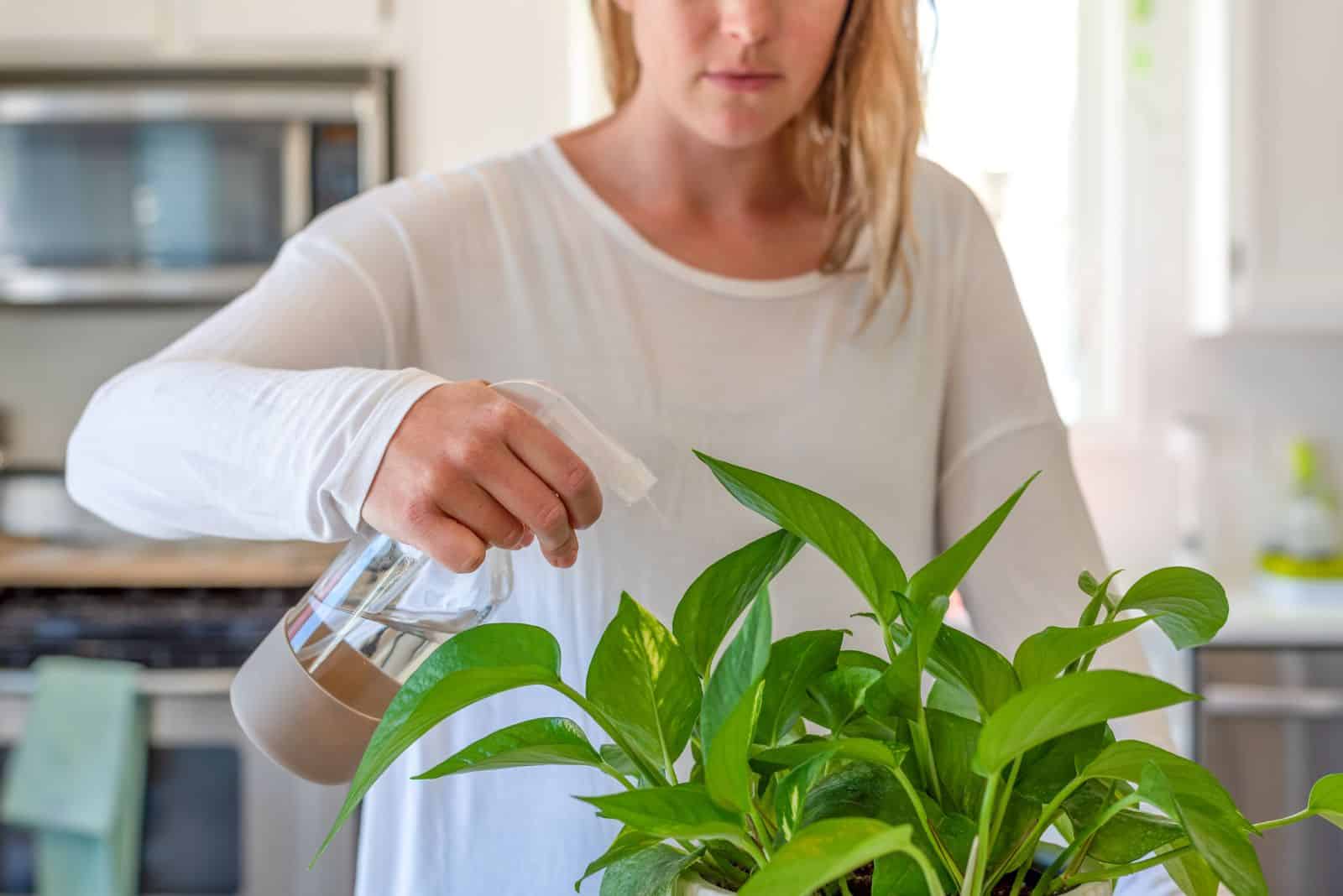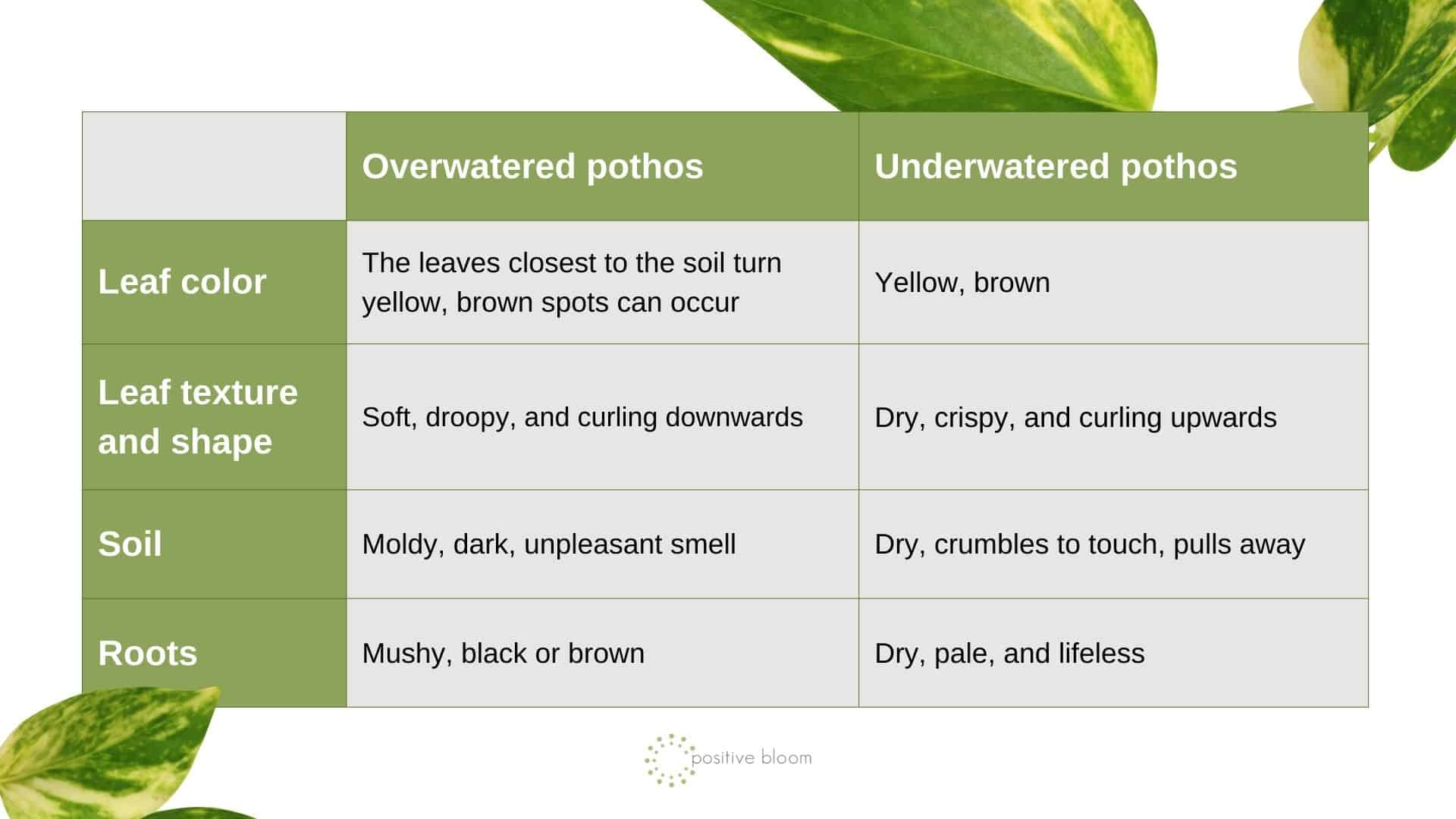I love Epipremnum plants mainly because they’re super easy to maintain. The majority of problems in pothos plants are related to watering.
In this article, I’ll tell you how much and how often to water pothos and discuss factors that may change the watering needs of this plant.
We’ll also go through the water type suitable for Devil’s ivy and which watering technique to use.
Once you learn all these things, your pothos is destined to thrive.
Let’s get started!
How Often To Water Pothos During The Growing Season
Pothos plants will need a lot of water during their growing season, i.e., spring and summer. They grow actively during this period and spend all their energy quickly.
You should water your Epipremnum aureum plant when the soil dries 1–2 inches below the surface.
It’s essential to maintain soil moisture around pothos roots, but you should never allow excess water to accumulate in the soil. By checking soil moisture each time before you add any water, you’ll avoid this problem.
Temperatures are higher during the summer months, and the water evaporation rate increases. You should check moisture in pothos soil three times a week during its growing season.
Here are some methods on how to check the moisture content in a pothos growing medium:
1. Put your finger in the soil. This technique is probably more suitable for experienced gardeners. Novice gardeners find this method unreliable and unattractive because of the dirt, I guess.
2. Use a wooden stick. You can check if your pothos needs water by putting a wooden stick in the soil. If some soil remains on the stick when you take it out, there’s still enough moisture.
3. Buy a moisture meter. The most reliable way to measure moisture and tell if pothos needs watering is by using a moisture meter. This cost-effective device is extremely beneficial for beginners as it gives you precise measurements.
Watering Schedule During Dormancy
Similarly to other common houseplants, pothos is dormant during the winter months. The reason is pretty simple: your plant needs rest after spending so much time and energy on new growth.
Water encourages new growth and can stress your pothos, so cut back on watering during the colder months!
Generally speaking, you need to check moisture in Devil’s ivy soil every 1–2 weeks during winter. But never add water if the soil is wet on the surface. Overwatering in pothos is most frequent during colder months.
Don’t worry if your pothos plant suddenly stops growing; it’s perfectly normal for the plant to show little to no growth during hibernation. (1)
Which Factors Change Pothos Watering Needs?
We’ve seen that Devil’s ivy needs more water during the growing season, but is there anything else that can change the watering needs of these plants? YES, there are a few factors that affect the needs of your pothos regarding watering.
Let’s see more in detail.
Soil
You most likely won’t have serious watering problems if you use the correct type of potting soil for pothos plants.
Pothos species need a free-draining potting mix with plenty of air pockets to provide the roots with good air circulation. If the soil is too compact, water will quickly clog the air spaces, and the roots will start rotting. (2)
You can blend equal parts peat moss, perlite, and vermiculite to get free-draining but also water-retentive soil.
The soil needs to be moist, so ingredients, such as vermiculite, should be incorporated. When you add perlite, pumice, sand, or any other similar material, you’ll allow excess water to drain and leave air pockets intact.
Another excellent way to avoid waterlogging issues in Epipremnum plants is by using planters that have drainage holes at the bottom.
Last but not least, don’t forget to add a little bit of organic fertilizer to pothos soil; I recommend mixing in worm castings before planting.
Here’s a video with more tips for making perfect soil for pothos plants:
Temperature
Another factor that plays a vital role in Devil’s ivy watering schedule is the temperature. The warmer the temperature, the more water your prized Devil’s ivy will need.
All pothos species flourish best at temperatures ranging from 65 to 85 degrees Fahrenheit. Any increase or decrease in temperature can change the watering needs of your pothos.
It’s also important to mention that you need to measure humidity if temperatures are lower or higher than recommended. Why? When temperatures are low and humidity is high, watering needs will be minimal as humid air prevents soil from losing water.
On the other hand, if temperatures are over 85 degrees Fahrenheit and humidity is low, you’ll need to water your pothos more frequently. The soil will lose water quickly due to the high evaporation rate.
Humidity
Epipremnum plants are native to humid environments, and humidity needs to be over 50% if you cultivate these plants indoors.
If the humidity in your home is above 50%, you won’t need to water your Devil’s ivy much. If it’s lower, you’ll need to increase the watering frequency and raise humidity ASAP.
Some of the best ways to raise indoor humidity are misting, using the pebble tray method, grouping plants, or using a humidifier. The last option is my favorite as there are some humidifiers that can monitor humidity at the same time.
As soon as humidity is in the recommended range, reduce watering your pothos to avoid overwatering.
Light
Many plant growers aren’t aware of the fact that the more light the plant receives, the more water it will need. Similar to humidity and temperature, light affects the water evaporation rate in the pothos soil.
Most types of pothos do well in low light conditions; the ones that need more light are those with variegations. However, the perfect light level for Devil’s ivy plants is bright but indirect light.
If you grow your pothos in lower light, you need to cut back on watering. The truth is that pothos plants will adapt to various light levels quickly, but they will never adapt to waterlogged soil
Size And Type Of Pot
A pretty pot doesn’t mean a good pot. In the plant world, the last thing you should worry about is the container’s appearance.
The porosity of the pot plays a major role in water evaporation (3), so the watering needs of your pothos can change depending on the material of the pot.
Planting pothos species in terracotta or plastic pots is preferable as these materials are porous and don’t heat too quickly. Avoid keeping your Devil’s ivy plants in metal pots because they heat too fast, and you can end up with underwatered pothos.
Another important thing to discuss is the size of the pothos container. When repotting your Devil’s ivy, don’t use too large a pot; a 2-inch larger container will suffice. Excess soil around pothos roots will retain more water, so you risk root rot.
Best Watering Technique And Type Of Water
Pothos plants respond well to both top and bottom watering techniques. When I started growing plants, I watered my plants from above, and the leaves constantly had water on them. This is very dangerous because the leaves can quickly rot.
Additionally, the soil doesn’t evenly saturate if you water it from the top, so you’ll need to do it more often. This makes the top watering technique more suitable for experienced growers.
If you are a beginner, I recommend bottom watering your Epipremnum aureum. You simply pour water into a container or a sink and place your pothos in it for some time. The growing substrate will gradually soak up the moisture, and the water will be equally distributed.
Type Of Water
You can have a perfect watering schedule, but if you use the wrong water type for your pothos, things can get out of control.
Rainwater is the best option for all houseplants; if you can’t save any, then distilled and filtered water will suffice.
When it comes to pothos plants, tap water isn’t a good option as it may contain harmful substances, such as chlorine and fluoride, which pose a threat to plant life. (4)
Here’s a video with more tips on watering pothos plants:
Overwatered vs. Underwatered Pothos
It’s always good to know the signs of stress in your plant, especially when it comes to watering. Underwatering and overwatering aren’t uncommon in pothos, so if you notice any of the signs shown in the table below, react immediately.
Let’s see which changes the pothos plant will display if it has watering issues and if the damage is caused by dehydration or too much water in the soil.
Wrapping Up
All plant growers are aware of how much damage inadequate watering can cause.
Low-maintenance plants, such as pothos, don’t need much water, and from my experience, it’s better to underwater than to overwater them.
You’ve seen how much and how often to water pothos. Never rely on a fixed watering schedule for your Devil’s ivy; factors such as light, humidity, temperature, and pot can change the plant’s watering needs.
Just follow our guidelines, and I’m sure you’ll have a thriving and happy pothos in no time.
Until next time!
References
1. Rohde, A., & Bhalerao, R. P. (2007). Plant dormancy in the perennial context. Trends in Plant Science.
2. An, Ni & Tang, Chao-Sheng & Xu, Shi-Kang & Gong, Xue-Peng & Shi, Bin & Inyang, Hilary. (2018). Effects of soil characteristics on moisture evaporation. Engineering Geology.
3. J. (1970). The effect of container porosity on root environment and plant growth. Plant and Soil.
4. Kumar K, Giri A, Vivek P, Kalaiyarasan T, Kumar B (2017) Effects of Fluoride on Respiration and Photosynthesis in Plants: An Overview. Ann Environ Sci Toxicol 2




